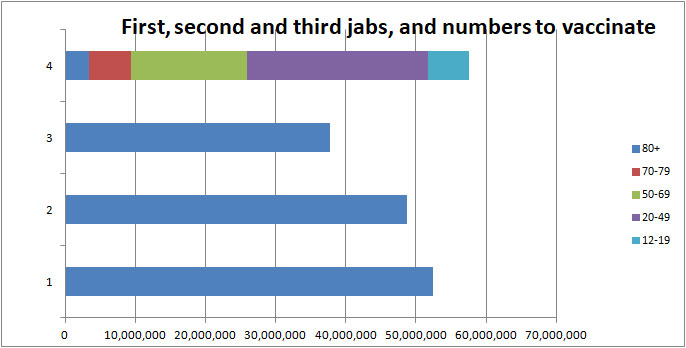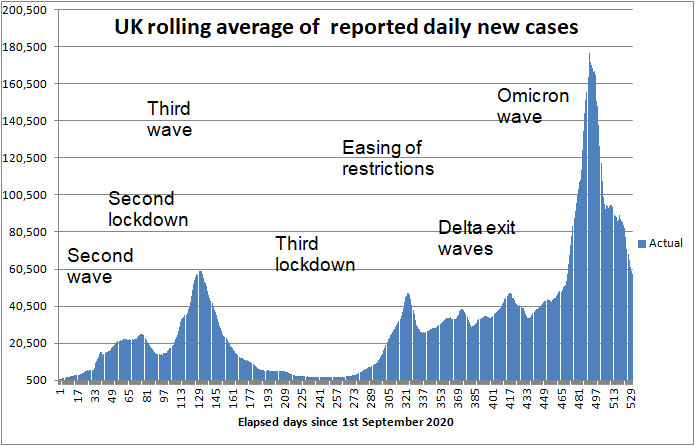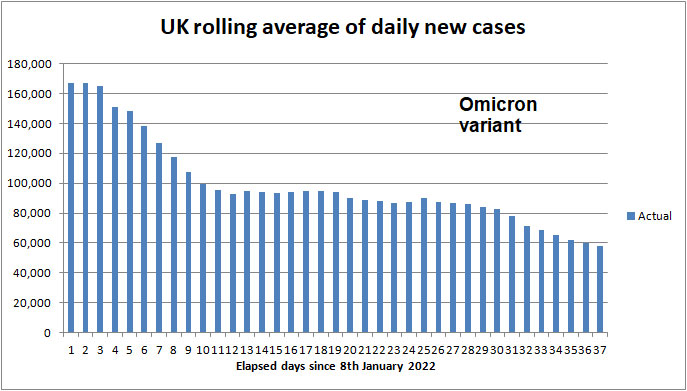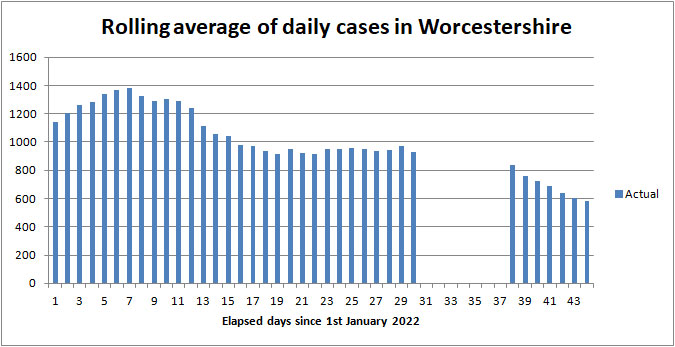
Angus and Rosemary's Miscellany
of Malvern - Other Resources
|
Coronavirus (COVID-19) epidemic weekly update for Malvern Seniors13th February 2022 BACK TO NORMAL PreambleWe keep an eye on the published government figures and monitor the media to asses the level of risk for Seniors in the Malvern Hills district. We also provide links to where further information can be found. This page is normally updated every Sunday between 1800 and 2400 hours GMT. Information about Coronavirus can be found on the NHS website: https://www.nhs.uk/coronavirus ContentsFurther information: About the Zoe COVID symptom study About the NHS contact tracing app SummaryFor the majority in the UK it's probably time for life to return to normal, especially for those who are in reasonable health and have had three doses of the vaccine. Sadly the situation may be more complex for the clinically vulnerable who will want to discuss their condition and precautions with either their GP or Specialist. In the UK, daily hospital admissions, the number of COVID patients occupying hospital beds and the number of patients on ventilators have been slowly falling during the last month. At last daily deaths from COVID are also showing a downward trend and there is speculation up to half these might not be 'true' COVID deaths. So that, despite daily cases remaining very high, hospital metrics all point to the pandemic being all but over. The picture of daily cases is gradually becoming fogged. The Zoe app suggests cases have gone down slightly this week, whereas the 'PHE' figures have gone down more, most probably because fewer people are taking PCR tests and reporting the results of their Lateral Flow tests. The figure for daily cases is therefore becoming an unreliable indicator. While the Omicron virus remains prevalent there is a fair chance we will all catch COVID-19 at some time or other. It may make us feel very poorly and send us to bed for a few days; and it could take a week or two for us to recover but, except for the very frail, we are unlikely to be hospitalised and our resistance to future infection should be bolstered. The main thing the government will be keen to avoid is a lot of people, such as nurses, being off sick at the same time. COVID hospital Intensive Care beds are now said to be mostly occupied either by those who are unvaccinated or have had only 2 doses of the vaccine, so make sure to get your booster jab if you have not already done so. Lateral Flow Device kits which only require a nose swab can be used to test for COVID at home, for example before either going to an event or visiting friends. However be aware they are not 100% reliable and you could be infecting others before there is enough virus for the test to show positive. A local summary of COVID data can be found on the Worcestershire Coronavirus Dashboard. Deaths are on page 7, and hospital beds on page 9. Note: use the arrow <> buttons at the bottom of the Dashboard screen to move between pages. Click for Worcestershire County Council COVID-19 news Click for Simple Summary of Malvern numbers on the Coronavirus dashboard Click for the latest UK Government Coronavirus advice How to get vaccinatedBy now we anticipate all Seniors are fully vaccinated, for others read on:- Under the government's plan to deal with the Omicron Emergency, all those aged 16+ years are now eligible to book a booster 3 months after their second dose. Click NHS link - Who can get a coronavirus (COVID-19) vaccine From Monday 31st January vulnerable children aged 5 - 11 years can be vaccinated; this may be by invitation - ask your GP. For information about walk-in centres in Worcestershire go to the website: and click the Vaccine Rollout tab at the top of the page. Click for information about vaccination at the Three Counties Showground Otherwise either see the NHS website for walk-in opening times and vaccine availability: Or click this link for more information and to book a vaccination on-line: Book a Coronavirus vaccination - NHS (www.nhs.uk) Or talk to your GP. Note: the immuno-compromised may be offered a third jab as part of their primary course, followed by a booster 3 months later. More about vaccinationsThe Omicron variant is now dominant and still spreading rapidly. It can make you 'very poorly' so it is essential to get your booster jab if you have not already had it. VaccinometerOur bar chart below shows the total number of:
Vaccinometer as of 13th February 2022 You won't see much change from last week's chart as the vaccination rate has slowed to a snail's pace compared to pre-Christmas presumably because all those that want to be vaccinated have had their jabs and the remainder have chosen not to despite the availability of vaccine. The population of the UK aged 12+ is about 58M, so were everyone in that age group to be fully vaccinated the lower two blue lines showing 1st and 2nd doses should ideally reach 58M. Progress towards that goal is now slow. Currently there are just over 5M in this age group who are unvaccinated, which is a lot, and 4M still to get their 2nd dose. That alone is not enough and a third jab is necessary to obtain protection from Omicron. Click for NHS video warning young people of the dangers of the virus for the unvaccinated. Vaccination statistics can be found on the Vaccination tab of the Coronavirus Dashboard. Booster jabsThe number of booster jabs given in England can be found in a spreadsheet on the NHS England website. Look in the data section for the COVID-19 daily announced vaccinations Excel file which gives a breakdown of jabs by region and age. Click for NHS COVID-19 vaccinations A summary can also be found on the Coronavirus Dashboard. The government says everyone aged 18+ years has been offered a booster jab. To date about 49M have had two doses, and 38M booster doses have been administered, suggesting 11M still to boost in the UK; but those under 16 years are not yet eligible for a booster jab, so probably about 6M still to boost. Vaccinations WorldwideA chart of the worldwide vaccination situation can be found on the Our World in Data website. Click for worldwide statistics Hint: click the country list on the left hand side of the screen to add or remove countries from the chart.
|
| Districts of Worcs | Cases | Weekly increase | Population |
| Bromsgrove | 28,282 | +588 | 98,529 |
| Malvern Hills | 15,114 | +617 | 77,545 |
| Redditch | 24,653 | +558 | 85,317 |
| Worcester | 27,327 | +783 | 103,542 |
| Wychavon | 29,981 | +984 | 126,240 |
| Wyre Forest | 25,717 | +547 | 100,957 |
| TOTAL | 151,074 | +4,077 | 592,130 |
| COMPARE WITH | |||
| County of Hereford | 41,293 | +1,320 | 195,000 |
| Leicester (city of) | 109,860 | +1,272 | 400,000 |
Cumulative cases reported by PHE in Worcestershire to 13th February 2022
Note: the weekly increase is indicative; the seven day average by area, which varies day to day, is an alternative metric that can be found on the Coronavirus dashboard.
The main point to note is that cases have almost halved in the last week.
Cases in Malvern Hills by age group
On the cases tab of the Coronavirus dashboard you can either select the county of Worcestershire or a local authority such as the Malvern Hills, and there you can find a heat map showing cases by age group over time and a chart comparing the number of cases under 60 years with those aged 60+.
The latest figures show the infection rate falling in those aged 0-59 and now flat-lining in those aged 60+ where the case rate is about 3 times lower.
The rolling number of cases per 100,000 per week reported to 6th February was 449 in the over 60s; and 1,394 in those aged 0 - 59 years.
Click for cases by specimen date age demographics in the Malvern Hills
Interactive maps
At the bottom of the Coronavirus Dashboard (daily update) page there is an Interactive Map which is coloured to show infection rates across the country. This shows cases falling in Scotland and the North of England, and especially in Wales.
Click for Interactive Map of COVID cases
Note: the Interactive Map works on desktop PCs but it's possible you may encounter difficulties using a tablet or smartphone.
Recent weekly cases to 7th February were still high: North Malvern 108; Malvern Link 75; Pickersleigh 81; Barnards Green 69; Malvern Wells and Priory 61; Callow End and Hanley 65; Upton and Welland 77.
Another map can be found on the Zoe COVID Study website indicating extrapolated cases based on reports from those using the Zoe app.
Click for People with COVID (estimated from the Zoe app)
Number of deaths
Statistics on COVID deaths are published by Public Health England, The Office of National Statistics, and NHS England.
 PHE figures
PHE figures
Public Health England reports there were 1,252 COVID (28) deaths in UK hospitals and care homes in the last week bringing the cumulative total to 159,570 (including deaths linked to repeat infections), with the daily average falling from 245 to 179 deaths per day.
In comparison averaged over recent years 1,700 people die daily from all causes.
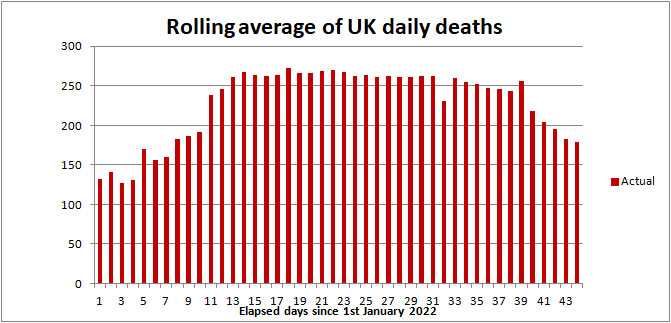
COVID-19 (28) death rate 1st January to 13th February 2022
Click to view the UK government Coronavirus Dashboard
Note: in half the cases recently reported by PHE it is thought COVID-19 was not the underling cause of death (see comments about ONS deaths below) so the true figure could be 90 deaths per day or 5% of all deaths.
ONS figures
The Office of National Statistics (ONS) separately reports registered deaths in England and Wales where COVID-19 is mentioned somewhere on the death certificate. The ONS figures lag the PHE figures by 10 - 14 days and do not include Northern Ireland and Scotland.
Click for national ONS data on deaths (Excel spreadsheet)
The ONS figures are broken down by District providing a glimpse of where deaths are occurring. The provisional cumulative total of COVID related deaths in Worcestershire reported by the ONS up to 28th January (week 4 of 2022) is shown below.
Note: the numbers are from the ONS Death Registrations-Pivot table
| Districts of Worcs |
Deaths 2020 |
Deaths 2021 |
Deaths 2022 |
Week 4 | Population |
| Bromsgrove | 164 | 142 | 9 | 1 | 98,529 |
| Malvern Hills | 61 | 98 | 5 | 1 | 77,545 |
| Redditch | 108 | 109 | 3 | 1 | 85,317 |
| Worcester | 87 | 134 | 8 | 3 | 103,542 |
| Wychavon | 157 | 154 | 8 | 2 | 126,240 |
| Wyre Forest | 171 | 132 | 5 | 1 | 100,957 |
| TOTAL | 748 | 769 | 29 | 9 | 592,130 |
Provisional cumulative COVID-19 deaths registered by ONS to 28th January 2022
Note: summation of rows 9 to 339 of the ONS deaths Registrations-Pivot table.
There was 1 death in a care home in Bromsgrove; 1 death in hospital in the Malvern Hills;1 death in hospital in Redditch; 1 death at home and 2 deaths in hospital in the city of Worcester; 2 deaths in hospital in Wychavon; and 1 death in a care home in Wyre Forest.
In England and Wales 1,383 COVID-19 related deaths were reported in the week to 28th January, 97 less than the week before. Of these 264 were in a care home, 123 at home, 17 in a hospice, 966 in hospital and 13 elsewhere.
Note: according to the ONS, COVID was the underlying cause of death in just 71% of these cases.
Click for ONS Coronavirus (COVID-19) latest insights: Deaths
Recent figures suggest Omicron COVID-19 related deaths as reported by ONS for England and Wales may have peaked at about 1,480 deaths per week towards the end of January 2022. Add 10% for Scotland and NI that would suggest the UK peaked at about 1,630 ONS deaths per week.
In comparison the rolling average of COVID-19 (28) daily deaths reported by PHE on 1st February was 263, or 1,841 deaths per week suggesting possibly 210 of PHE deaths had no mention at all of COVD-19 on the death certificate.
The provisional UK COVID-19 death toll (as reported by PHE and ONS) for all weeks of the epidemic can be found on the Deaths tab of the Coronavirus Dashboard.
NHS England figures for Worcestershire
The table below shows latest COVID deaths in Worcestershire hospitals reported by NHS England on 11th February 2022.
| Worcestershire | Cumulative deaths | Past week |
| Acute hospitals | 945 | 3 |
| Care hospitals | 67 | 1 |
| TOTAL | 1,012 | 4 |
Click for NHS COVID-19 total announced deaths
Click for Summary of Malvern numbers on the Coronavirus dashboard
Risk of COVID-19 death by age band (Delta and Omicron)
NHS England provides an analysis of COVID-19 deaths in hospital in England and Wales by age band. Shown below is a snapshot of 3,971 recent deaths for the period 7th January 2022 to 3rd February 2022.
During this period deaths from Delta probably fell while those from Omicron increased. We do not know the exact mix, but there is an indication the risk of death is moving towards those aged 80+ years, who will generally be more frail and have co-morbidities.
| Age band | Number of COVID deaths | % of deaths |
| 0 - 19 | 11 | 0.3 |
| 20 - 39 | 43 | 1 |
| 40 - 59 | 287 | 7 |
| 60 - 79 | 1,404 | 35 |
| 80+ | 2,226 | 56 |
Relative risk of COVID-19 death by age band
The latest figures show the risk of death has fallen slightly in those aged 40 to 79 years, rising in those aged 80+.
Those aged 60+ still account for more than 90% of deaths, but remember that due to vaccination the death rate as a proportion of new cases is five to ten times lower than in 2020.
One commentator on the TV news this week suggested the risk of the elderly dying from Omicron is now just double that of dying from the Flu (note: we haven't found evidence to support this).
Many historic deaths are likely to have been of the vaccine-hesitant, and those with co-morbidities such as Diabetes, the frail, and those that are immuno-compromised. Pregnant mothers, the overweight and deprived individuals with a poor diet are also said to be at increased risk.
An NHS leaflet offered to patients being admitted to hospital suggests we are at higher risk of complications from COVID-19 infection if we have one or more of the following conditions:
-
Age over 70 or Male over 50;
-
Lung problems (including asthma, COPD, emphysema, bronchitis, bronchiectasis;
-
Heart disease
-
Diabetes
-
Chronic kidney disease
-
Liver disease (eg hepatitis, cirrhosis)
-
Brain or nerve problems (eg Parkinson's disease, motor neurone disease, multiple sclerosis, cerebral palsy)
-
You have a condition that increases the risk of infection
-
Take medication that affects the immune system, (eg steroids)
-
Very obese (BMI over 40)
-
Pregnancy
See link to the latest UKHSA vaccine surveillance report below which points to an analysis covering a mix of Delta and Omicron cases that also highlights that many deaths are now of vaccinated individuals by virtue of a large proportion of the population being vaccinated and the vaccines not giving 100% protection.
Click for UKHSA COVID-19 vaccine surveillance report Week 5, 3rd February 2022
 Healthcare numbers
Healthcare numbers
The UK government Coronavirus Dashboard includes important information about healthcare statistics and NHS bed occupancy.
| Hospital COVID cases (UK) | Number | Change since last week |
| Patients currently in hospital | 12,753 | -1,881 |
| Patients on ventilation | 430 | -48 |
| Patients admitted daily | 1,395 | -201 |
Headline summary of patients in hospital reported on 13th February 2022
The trend in UK COVID-19 bed occupancy continues downwards.
Bed numbers by region in England
Tabulated figures for COVID bed occupancy in England can be found on the NHS England website and these give a good indication of direction of travel:
Click for NHS England COVID-19 Hospital bed Activity statistics
Note: see the latest Daily Admissions and Beds spreadsheets, then look for all COVID beds.
| Region | 4th February 2022 | 11th February 2022 | 15th January 2021 |
| London | 2,321 | 2,042 | 7,811 |
| Midlands | 2,358 | 2,033 | 5,890 |
Comparison of All beds COVID data for London and Midlands
In the last week the number of COVID-19 General and Acute beds fell by about 13% in London and the Midlands.
For the same period, COVID beds in England fell from 12,032 to 10,367 a drop of 14%.
For comparison, the number of beds occupied during the peak of the epidemic in January 2021 is shown in red in the right hand column of the table.
 Worcestershire hospital beds
Worcestershire hospital beds
Tabulated figures for bed occupancy in Worcestershire Acute and Care hospitals can also be found on the NHS England website.
There were 84 patients in hospital with Coronavirus on 11th February 2022 of which 4 were ventilated beds. Roughly 31% of the peak experienced last January.
Some of these may be patients testing COVID positive after admission to hospital for other reasons.
Note: Healthcare statistics can be found on the Healthcare tab of the UK Coronavirus Dashboard. At the top of the page where it says Healthcare in United Kingdom, click the drop down arrow to select Area Type as NHS Trusts, and Area Name as Worcester Acute Hospitals.
Click to view Worcester healthcare figures
Alternatively,
Click for Summary of Malvern numbers on the Coronavirus dashboard
Deaths in Malvern Hills
There was 1 death within 28 days of a positive test for coronavirus reported on 13 February 2022.
Between 7 February 2022 and 13 February 2022, there have been 2 deaths within 28 days of a positive coronavirus test.
Forecast for the week ahead
Trends suggest that during the next seven days (up to 20th February) the cumulative total of UK COVID-19 cases reported by PHE on the Coronavirus Dashboard could increase by 400,000 towards 18,750,000 with the rolling average of daily new cases falling towards 45,000.
In Worcestershire up to 4,000 new cases of the Omicron COVID-19 variant can be expected, and up to 500 cases in the Malvern Hills district.
The number of UK COVID (28) deaths (as recorded by PHE) may increase by up to 1,050 towards 160,650 during the 7 days ending 20th February 2022, with the average daily death rate hovering around 150.
In the county of Worcestershire, assuming a 0.1% death rate, the 4,077 new cases this week could translate to 4 COVID deaths per week by the first week in March.
Daily hospital admissions can be expected fall towards 1,000.
Longer term outlook
General
Half term (next week) should cause cases to dip further, but how fast cases fall during the next quarter is impossible to predict, especially given the possibility all legal restrictions will be removed on 24th February. At some point a background level of cases will probably be reached but we have no idea of whether that will be close to where we are now or a lot lower.
See summary of links section for UCL and IHME modelling projections.
Do not be surprised if it's another 6 weeks before deaths drop to 10% of what they are now.
Ratios
For a fixed level of vaccination, daily cases have been a signpost to whether daily hospital admissions and deaths are going to go up or down. Based on our heuristic 'rules of thumb' hospital admissions and deaths during January appeared to be to following daily cases very roughly in the ratio:
-
Hospital admissions 1:75 of daily cases reported by PHE, lagging by 7 days, of which perhaps up to half are 'true' COVID admissions;
-
Deaths 0.18% of daily cases reported by PHE, lagging by 15 days of which perhaps only half are 'true' COVID deaths.
-
UK Hospital bed occupancy - roughly 8 times daily hospital admissions, lagging by about a fortnight.
Our guess is that daily cases are no longer being accurately reported and are consequently becoming an increasingly weak signpost to hospitalisation and deaths.
Advice for Seniors
We judge the risk of exposure to the Omicron variant still to be HIGH; see our riskometer opposite.
How this affects you will depend on your vaccination status. UKHSA say those who have had two doses plus a booster have roughly a 12% chance of being hospitalised compared to the unvaccinated.
Two doses give little or no protection.
6M people remain unvaccinated in the UK and for many time is running out; perhaps up to 6,000 will die unnecessarily in coming weeks.
Recently there have been no more than 9 COVID related deaths per week in Worcestershire which has a population of 600,000 so we currently judge the risk of death for triple vaccinated Seniors to be fairly LOW while the risk of Long COVID might be MODERATE .
In these uncertain times, when it is quite possible, despite being triple vaccinated, for Seniors to become ill with the Omicron variant of COVID-19, the simple safeguards to remember are to:
-
book your booster dose as soon as you are contacted by either your GP or the NHS; between five days and two weeks after the booster most people should be well protected from severe illness;
-
don't forget your flu jab;
-
wash your HANDS thoroughly, using soap and hot water, for 20 seconds, including after handling deliveries to your home, to kill virus picked up from contaminated surfaces (see note 1);
-
ideally wear either a well fitting FACE covering, FFP2, or N95 face mask when unavoidably near other people for example when in shops, health-care settings, and when using public transport;
-
SPACE at least 2 metres from people you don't feel safe with (see note 2);
-
preferably socialise with friends and other households outdoors in the FRESH AIR else, if you are indoors, either ventilate by keeping windows open as far as is practicable or put a HEPA air purifier in the room;
-
consider avoiding crowded indoor settings and minimise TIME near strangers;
-
self-isolate and take a Lateral Flow test if you feel unwell with cold or flu like symptoms; according to the Zoe COVID Study the current top five symptoms amongst the double vaccinated and children, in order of prevalence, are said to be runny nose, headache, sneezing, sore throat, and persistent cough, which are often hard to distinguish from a common cold - you might alternatively suffer from fever with a temperature of up to 103 deg F, and a slight reduction in sense of taste;
-
consider taking a Lateral Flow test before visiting others (see note 3);
-
respect others and give them space.
Notes:
1) Wash your hands thoroughly before touching your face to avoid transferring virus from contaminated surfaces to your mouth, eyes and nose. If outdoors use an alcohol based hand gel.
2) Two metres is further than you think - roughly an arm and a walking stick away.
3) The COVID Symptom Study people suggest that if you have symptoms of a common cold there is roughly a 40% chance you might have COVID.
Annex
Commentary
This week
On Tuesday we learnt the Novavax vaccine was approved by MHRA on 3rd February 2022.
Novavax COVID-19 vaccine Nuvaxovid approved by MHRA
On Wednesday the PM announced the government now hoped to relax all COVID restrictions in England, which are due to expire 24th March, before the end of February. What this means in practice is that it will no longer be a legal requirement to quarantine after testing COVID positive - it would become a personal decision.
We learned Norway and Sweden were dropping most control measures, like Denmark did last week, so the UK would simply be following in the steps of other European nations.
Click for BBC report - Europe entering Covid pandemic 'ceasefire', says WHO
Radio 5 presenter Rick Edwards has COVID following his wife Emmer Kenny getting it.
Some hospitals still restricting visitors.
On Thursday we heard Prince Charles has COVID for the second time. Prof Tim Spector also has COVID as does the First Minister of Wales, Mark Drakeford, so it sounds like we are all going to get it.
On Friday the minutes of the SAGE meeting on 10th February were published. Make of them what you will.
Click for SAGE 105 minutes: Coronavirus (COVID-19) response, 10 February 2022
Click for SPI-B: Social and behavioural impacts for lifting remaining restrictions, 10 February 2022
COVID video updates
The usual charts can be found in the Zoe COVID Study and Independent SAGE weekly updates.
Click to watch Zoe COVID Symptom Study update on 10th February 2022 presented by Tim Spector (worth watching).
Click to watch Independent SAGE update on 11th February 2022
The Independent SAGE update starts with the usual review of the charts and is followed by a discussion of whether you can declare the pandemic over and long COVID.
U3A
Some groups have started meeting again in person. Attendance is gradually rising.
Overseas travel
Refer to current government advice, and prepare contingency plans in case circumstances change in the country you are visiting.
List of vaccines
Here is the updated list of COVID-19 vaccines ordered by the UK. It looks as though for now the government has settled on Pfizer as first choice with Moderna second and Astrazeneca held in reserve.
Valneva has been cancelled, and approval has not yet been sought for using Novavax in the EU and US although approval has been sought for use in third world countries.
For two doses plus boosters, only about 200M doses will be needed in 2021 and Jan/Feb 2022 for the population of the UK. The government has now signed deals to buy 114 million additional doses of the Pfizer (54M) and Moderna (60M) vaccines to use in 2022 and 2023.
The press announcement goes on to say that 60M doses of Novavax vaccine are expected to be delivered in 2022 and 7.5M doses of GSK/Sanofi, so there seems no intention to cancel these late arrivals.
Click for Guardian report - Novavax expected to be become fourth Covid vaccine available in UK
| COVID-19 vaccine | Doses ordered (million) | Status |
| Pfizer BioNTech, two dose, -70 deg C | 40+60+35 | Approved, deliveries continuing, made in Belgium (EU). An additional 60M doses have been ordered for booster shots for the most vulnerable in the autumn. A further 35M doses were ordered in August 2021 for delivery in 2022. |
| Astrazeneca, two dose, fridge | 100 | Approved for those aged 30+ years; deliveries continuing. Batches made in UK, Belgium and India. |
| Moderna, two dose, -20 deg C | 7+10 | Approved. First deliveries to Wales and Scotland 7th April 2021 then England 13th April; mainly for those aged under 50 years awaiting vaccination. |
| Valneva, two dose | 60+40 order cancelled |
A jab from French company Valneva will be made in Livingston, West Lothian, Scotland. Order cancelled September 2021. Delivery had been expected to start in second half of 2021. |
| Janssen, single dose | 20 | Approved, a jab from Belgian firm Janssen, owned by Johnson and Johnson; UK approval 28th May. Order reduced from 30 to 20M. |
| Nuvaxovid | 60 | A jab manufactured by US firm Novavax being made in Stockton-on-Tees UK. Glaxo Smith Kline (GSK) contracted to fill and package vials. Approved by MHRA 3rd Feb 2022. JCVI to advise how vaccine will be used. |
| GSK Sanofi | 60 | Some delay due to adjusting the formula to give better protection to the elderly; expected approval and delivery of 7.5M doses in 2022. |
| Curevac | 50 ? | Contract placed with German company Feb 2021. Possible source of new variant vaccine; disappointing trial results have resulted in the company working on a second generation vaccine. Future uncertain. |
Table of vaccines ordered by the UK government
 Present rate of new cases
Present rate of new cases
The average rate of infection per 100,000 population per week copied from the Coronavirus Dashboard is shown in the following table.
| Region | Case rate (last week) |
Case rate (this week) |
| England | 973 | 748 |
| Wales | 496 | 389 |
| Scotland | 441 | 793 |
| Northern Ireland | 1,532 | 1,352 |
| London (region) | 842 | 673 |
| Worcestershire | 1,115 | 862 |
| Malvern Hills | 1,202 | 1,008 |
Seven day Case Rate per 100,000 reported 12th February 2022
Apart from Scotland cases are down this week with Wales doing best.
As a yardstick we suggest a figure of below 10 can be considered LOW, so there is a long way still to go.
How to request a COVID test
In order to protect others it is important to get a test and self isolate if you feel unwell with either classic COVID symptoms, or cold and flu like symptoms which can be caused by the Delta variant.
There are now two types of test you can get. The more accurate PCR test involving a throat and nose swab which is sent to a laboratory for analysis and the Lateral Flow Device test.
Click for government guidance on types of tests
Getting a PCR test
Click the link below for information on how to get a free NHS PCR test if you think you may have Coronavirus:
https://www.gov.uk/get-coronavirus-test
We feel the website discourages people from seeking a PCR test who don't have all the classic symptoms. If you feel strongly enough, press on answering the questions so as to get your PCR test.
In case of difficulty you can try phoning the Coronavirus contact centre by dialing 119.
Alternatively settle for a 'Nasal swab' Lateral Flow Device test in the comfort of your own home (see below).
According to Google there is a 'drive through' COVID testing station at County Hall near the Countrywide Centre, and a 'walk through' at Pershore.
There is also a COVID testing station at the Worcester Royal Hospital for screening patients before admission.
If you cannot get to these you can order a home PCR test kit.
If you test COVID positive you should self-isolate for 10 days.
Getting a Lateral Flow Device test
Lateral Flow Device tests (LFD) can either be booked at Claremont Pharmacy in Barnards Green, Evans Pharmacy in Malvern Link, or taken at home.
The test is intended to screen those who do not show the classic symptoms of COVID-19 and provides a means to check you are 'virus free' at home - either before visiting an elderly person, going to work, or attending a crowded event. It also provides a means to check whether or not you have Coronavirus if you are feeling poorly with cold and flu like symptoms.
 You
can collect home test kits,
for example packaged as the COVID-19 Self-Test (Rapid Antigen Test) in boxes
of 7 tests, from Malvern library, the Co-op, and most pharmacies such as Boots and Murrays in Church
Street, Claremont House and Lloyds in Barnards Green, Murrays at Prospect
View, Evans and Murrays in Malvern Link, and Boots and Morrisons on the
Enigma Retail Park.
You
can collect home test kits,
for example packaged as the COVID-19 Self-Test (Rapid Antigen Test) in boxes
of 7 tests, from Malvern library, the Co-op, and most pharmacies such as Boots and Murrays in Church
Street, Claremont House and Lloyds in Barnards Green, Murrays at Prospect
View, Evans and Murrays in Malvern Link, and Boots and Morrisons on the
Enigma Retail Park.
If collecting from a pharmacy you now have to go on-line and get a collection code to present to the pharmacy in order to obtain a pack of 7 tests. This involves giving NHS Test and Trace your email and/or mobile phone number and address.
http://www.gov.uk/get-collect-code
The LFD now comes in two versions.
-
The Throat and Nose Swab kit;
-
The Nose Swab only kit (Orient Gene, Acon Flowflex and MP Biomedicals).
(Lateral Flow Device cassette shown on the right).
ACON Flowflex comes in a blue and white pack.
Orient Gene comes in a green and white pack.
MP Biomedicals come in a blue, white and grey pack.
Click for instructions for using the LFD test kits
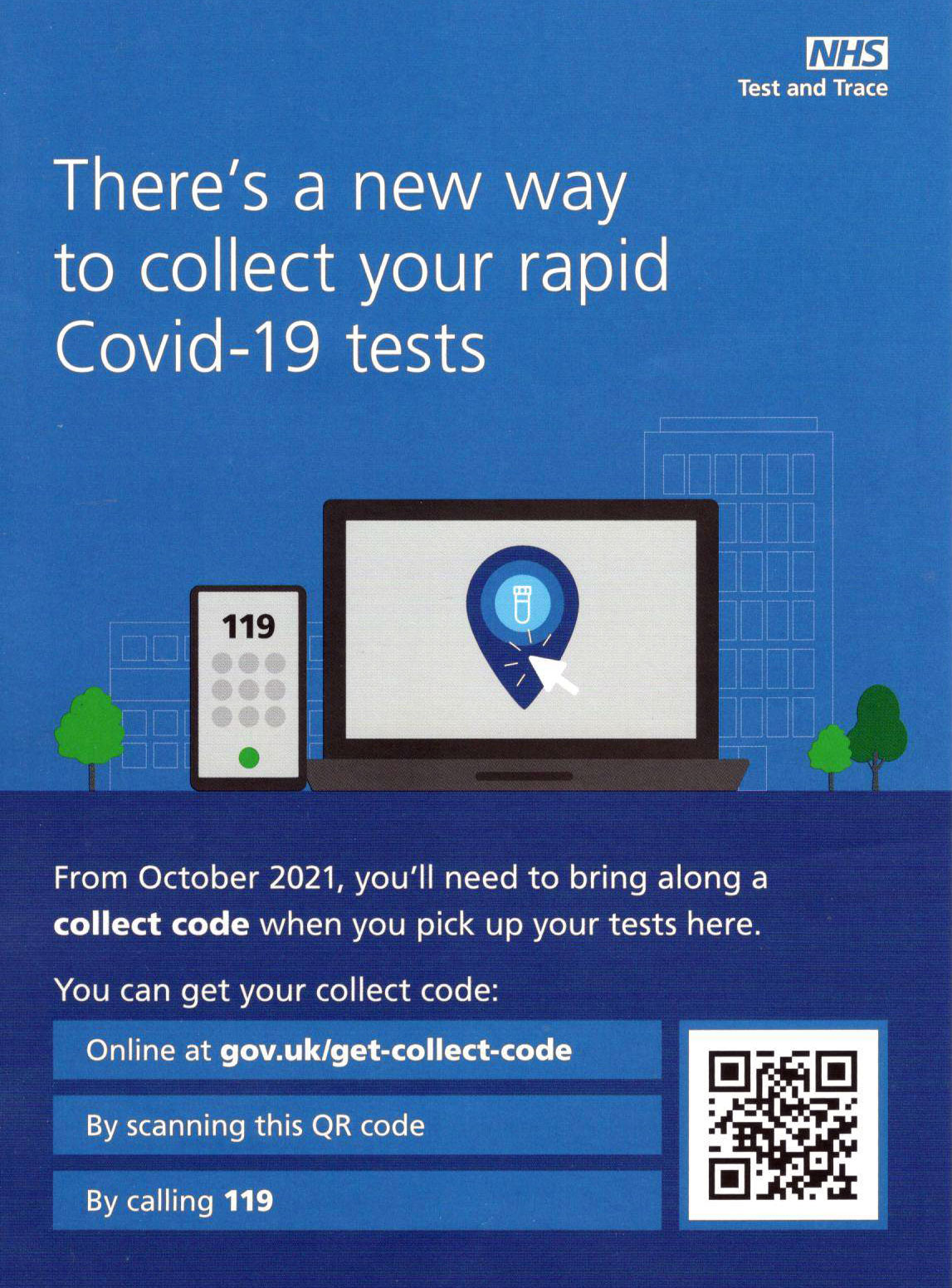
Leaflet at Boots the Chemist
The new Nasal swab test kit which only requires a nose swab is the easiest to use and the best one to get but it is not yet widely available. On 10th November we found Boots in Church Street and Malvern Library were still supplying the old Throat and Nose kit; Murrays in Church Street had the new kits and Malvern library thought the library in St John's Worcester might have the new kits.
Click for NHS information on Rapid Lateral Flow Test sites and collection sites in Malvern
Hint: to see the list, click on 'filter' and then 'pick up sites for test kits' checkbox.
Click for WCC info about Lateral Flow Tests
In our opinion, many Seniors will find the classic Throat and Nose Swab home test kit difficult to use as you need to rub the tonsils or thereabouts with the swab-stick without touching the tongue, teeth, cheeks, gums or any other surface before swabbing the nose. Doing this standing in front of a mirror on your own without gagging while holding a torch in the other hand, won't be easy unless you have a steady hand and good eyesight.
The Nose Swab kit is by far the best one for testing yourself at home.
If you test COVID positive you should isolate and take a more accurate PCR test to confirm the result.
NHS Test and Trace want people to report the result of their home LFD tests within 24 hours at:
www.gov.uk/report-covid19-result
This helps NHS Test and Trace monitor where the issue of the free LFD tests is proving most effective and the spread of the disease.
However, it's tedious to enter your Lateral Flow Test result on the government website and we imagine many people now don't bother.
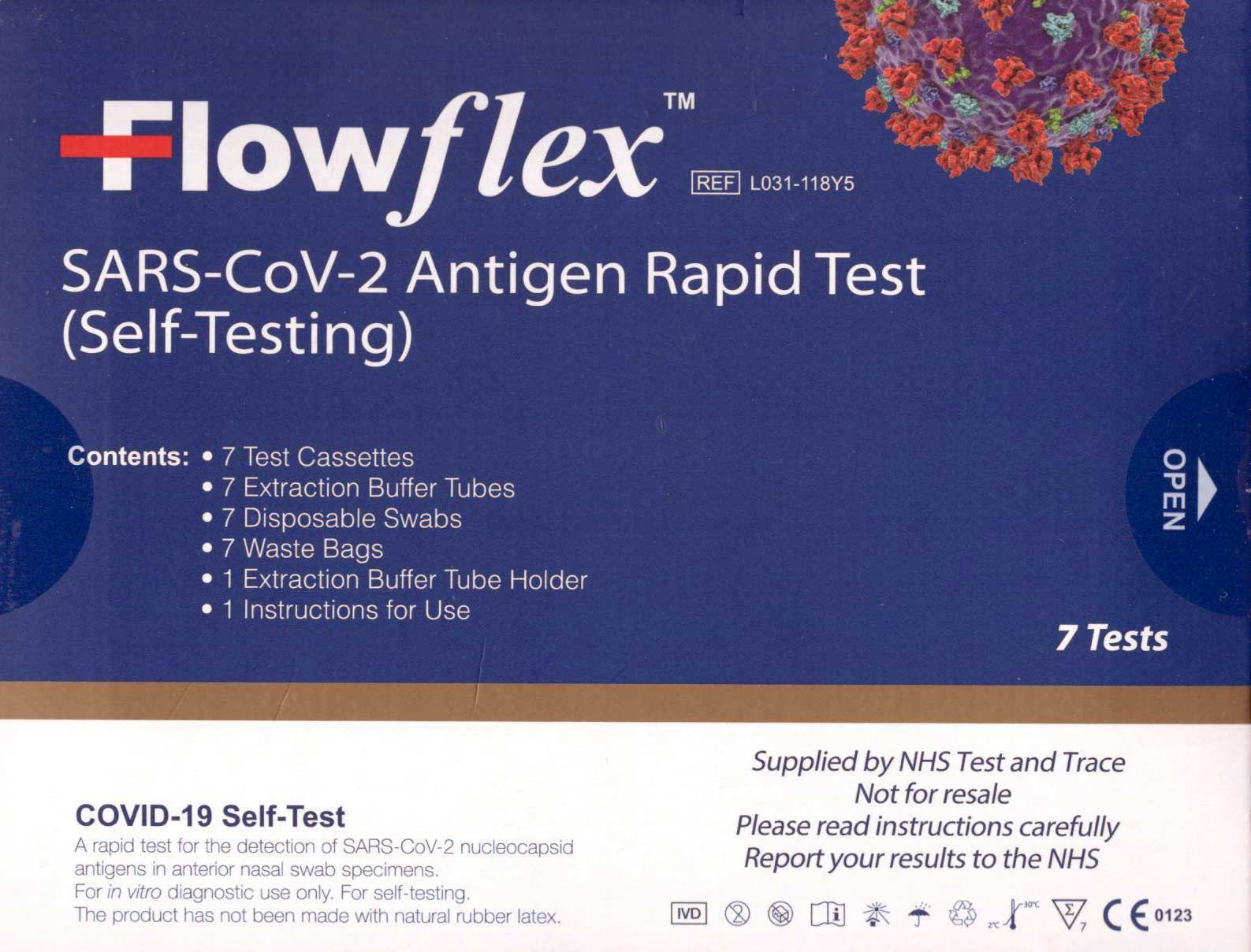
Nose swab home test kit obtained from Murrays
About the COVID Symptom Study app (Zoe)
 You
can help others by downloading the COVID Symptom Study app onto your
smart-phone or Ipad and reporting how you feel either daily, or as you are
able. Note there is no desktop PC version for Windows.
You
can help others by downloading the COVID Symptom Study app onto your
smart-phone or Ipad and reporting how you feel either daily, or as you are
able. Note there is no desktop PC version for Windows.
For further details click this link: https://covid19.joinzoe.com
The Zoe app, which is easy to use, allows you to report whether or not you are feeling well and if you have had a test for COVID. This helps Kings College London monitor the spread and symptoms of the disease and give advice to government. This is an important source of data as we progress through the EXIT wave.
There are questions allowing you to enter your vaccine type and whether any side effects; this now includes boosters and flu jabs.
About the NHS COVID-19 contact tracing app (England)
Release of the NHS COVID-19 contact tracing app for Apple and Android smartphones was announced on 24th September 2020.
Click this link for NHS Coronavirus app information
If you have been close to someone who has tested COVID positive, your smart-phone will be pinged and you may be advised to self-isolate
The period for self isolating keeps changing.
You can now take an LFD test from 6 days after the day your symptoms started, or the day your test was taken if you did not have symptoms, and another LFD test at least 24 hours later.
If both these test results are negative, and you do not have a high temperature, you may end your self-isolation.
Otherwise the isolation period is 10 days.
Bear in mind some individuals may take much longer to fully recover.
Note: be aware triple vaccinated individuals can still catch the Delta variant of the Omicron variant and pass it on to others.
About the NHS app and Covid Pass
An NHS COVID Pass shows your coronavirus (COVID-19) vaccination details and/or test results. This is your COVID-19 status. You may be asked to show your pass to travel abroad, or at events and venues in England asking for proof of your COVID-19 status.
For large UK events you may get in either by the fact:
-
you are fully-vaccinated;
-
you have had COVID as recorded by a positive PCR test;
-
you have taken and reported a recent Lateral Flow test.
You will need the NHS app installed on your smartphone and be registered with the NHS in order to display your vaccination status.
Note: this is not the NHS COVID-19 app
If you don't have a smartphone you should be able to login from a PC to obtain a printed copy.
Click to login from a desktop computer or laptop
You can use your NHS login when signing in to report the result of Lateral Flow Device tests taken at home, which must be done within 24 hours.
Summary of Links
Symptoms
Article about the effects of Coronavirus on the human body
Reporting and how to obtain a test
How to get a test
https://www.nhs.uk/coronavirus
About joining the Zoe COVID Symptom Study:
Guidance
UK government Coronavirus guidance
COVID-19 Response: Autumn and Winter Plan 2021 for England
UK Health and Security Agency (UKHSA) website
COVID Alert states
Guidance on UK COVID-19 alert level methodology: an overview
COVID-19 Alert Level lowered to 3 on 10th May 2021
Tiers
Guidance on tiers: what you need to know
Government postcode checker to find tier for other areas
Statistics
UK government COVID-19: Omicron daily overview
UK government Coronavirus Dashboard
Coronavirus Dashboard Interactive Map
ONS data on deaths in England and Wales (Excel spreadsheet)
NHS England COVID-19 Daily Deaths
NHS England COVID-19 Hospital Admissions
NHS England vaccination statistics
Worcestershire Coronavirus Dashboard
Worcestershire COVID-19 Vaccinations Dashboard
HSA COVID-19 vaccine weekly surveillance reports
Information about NHS hospital bed numbers: past, present, future
A glimpse of the worldwide vaccination situation can be found on the Our World in Data website.
Click for chart showing % vaccinated
Modelling
A forecast of the progression of the COVID-19 epidemic can be found on a University College London (UCL) website.
Click for UCL Long-term forecasting of the COVID-19 epidemic
A projection of the future COVID-19 death toll and daily deaths can be found on The Institute for Health Metrics and Evaluation website.
Click for IHME projection of COVID-19 deaths
Reports
Coronavirus (COVID-19) latest insights by ONS
A live roundup of the latest data and trends about the coronavirus (COVID-19) pandemic from the ONS and other sources.
The bigger picture
Worldometer summary of coronavirus cases worldwide
European Centre for Disease Prevention and Control info
https://www.ecdc.europa.eu/en/geographical-distribution-2019-ncov-cases
World Health Organisation info
Window on the USA
Centre for Disease Control (CDC)
Find maps and charts tracking cases, deaths, and trends of COVID-19 in the United States.
American Association of Retired People (AARP)
Worcestershire
Help:
http://www.worcestershire.gov.uk/here2help
Worcestershire County Council COVID-19 information:
http://www.worcestershire.gov.uk/coronavirus
Here you will find a useful link,
'Website: Number of new cases by date in Worcestershire'
which displays interesting COVID charts and statistics for Worcestershire
Miscellaneous
Spanish Flu
Dr Jeff Kildea's commentary about the 1919 outbreak of Spanish Flu in Australia
Views of Martin McKee, Professor of European Public Health
Follow Martin McKee on Twitter
SAGE membership
Scientific Advisory Group for Emergencies (SAGE)
Scottish government:
Link to Scottish Government website
Link to Postcode checker for COVID restrictions by protection level in areas of Scotland
Welsh Government:
Guidance on COVID alert levels in Wales

The interpretations and opinions expressed are our own
Last updated 13th February 2022
 Blogs
>
Blogs
>